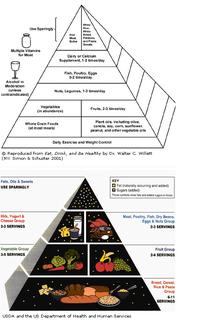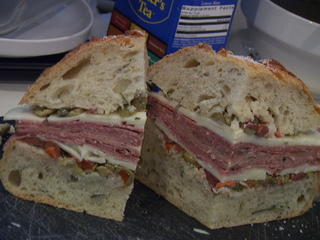
In 1994 the USDA released their first nutritional pyramid guide. This was, needless to say grossly inaccurate (I imagine most people wouldn’t think it healthy to eat between 6 and 11 servings of grain per day). We’ve learned a little bit in the last 11 years that show the original to be not only inaccurate but very unhealthy.
(old pyramid) The bottom layer (bread, cereal, rice and pasta) lumps all grains together, when there’s an important difference between whole and processed grains. Refined carbohydrates (bread, pasta, sweets, table sugar etc.) are absorbed into the bloodstream too quickly, because there is no bran left on the grain for your body to breakdown in digestion. As the starch is absorbed into your blood and broken down into glucose your blood sugar rises dramatically. In order to compensate for the elevated blood sugar level your pancreas must secrete insulin into your blood. Aside from putting a strain on your pancreas, a state of heightened blood sugar allows for fast calorie absorption into your blood and ultimately faster weight gain. When people are overweight, even slightly, their pancreas must work harder than normal to supply the larger mass with insulin. This eventually leads to pancreatic failure resulting in a number of health problems including onset diabetes. The new pyramid recommends refined carbohydrates to be eaten sparingly.
Various artificial sweeteners are usually unhealthy. High-fructose corn syrup or HCS, was created in the 80’s by a Japanese company. Because it is six times sweeter than sugar, it quickly took over as main sweetener in soda and fruit juices along with most beverages sold. It is not metabolized properly by the body because of it’s chemical structure and goes straight to your liver and puts a huge strain on it. Because of it’s high sugar content and , high-fructose corn syrup should be avoided. Aspartame (marketed under the brand name nutra sweet) aside from having unappetizing qualities, is but no means healthy and is known to cause serious health problems in children under the age of 2. Otherwise it is little to no risk. Sucralose is a chemical manufactured from sucrose (table sugar) that is too complex to be metabolized by your body. It passes through your digestive system without raising blood sugar levels or increasing insulin production. Since no carbohydrates (which have 4 calories per gram) are digested, it does not affect your calorie consumption. Sucralose has not been shown to cause any health problems and is marketed under the brand name Splenda.
Along with grains, all fats and oils are lumped together in one category, when some are healthy and some are not. To understand this difference I must briefly digress into a little chemistry, but bear with me, it all comes together.
Fats are long molecules made of chains of carbon and hydrogen atoms with other miscellaneous elements. When two carbon atoms are double bonded together this leaves an opening in ‘the chain,’ and it is ‘un-saturated.’ If there is more than one carbon-double-bond the fat becomes ‘poly-unsaturated.’ And if there are no double bonds, the chain is full or ‘saturated.’ These chemical differences affect a number of factors including melting temperature. Un-saturated fats, or oils, stay liquid at room temperature (and usually come from plants) and thus are more likely to stay liquid inside your body. Because of the nature of the molecular structure; saturated fats melt at much higher temperatures and are more likely to stay solid inside your body. Your brain is composed almost entirely of fat and needs to be constantly replenished. Your cells use fat to lubricate their walls.
The double bond(s) of an un-saturated fat make it susceptible to oxidation which causes rancidity. Rancid foods are not shown to be unhealthy but may contain free-radicals, which have been strongly linked to cancer. As a result, un-saturated fats have a relatively short shelf-life. By adding hydrogen and thus completing the chain - or saturating the fat - the molecule goes from a ‘cis’ formation to a ‘trans’ formation. This process is used in several commercial products to increase overall life and is called ‘hydrogenation.’ The terms ‘cis’ and ‘trans’ describe the shape of the molecule. ‘trans’ fats have been linked with a number of heart problems and increase your risk of heart disease immensely. These fats are shown to cause a serious health risk and should be avoided entirely. Margarine and other butter substitutes are made from this same process, along with most processed/frozen foods.
Diets high in saturated fat lead to high levels of LDL (low-density lipoprotein) cholesterol, and greatly increase the risk of heart disease and atherosclerosis in both men and women. Heart disease is almost always linked to high levels of LDL cholesterol. On the other hand, diets high in un-saturated fats lead to high levels of HDL cholesterol (high-density lipoprotein) which is inversely proportional to risk of heart disease. Diets high in red meat and dairy fat have extremely high instances of heart disease, where diets high in plant oils and vegetables, low in saturated fat, have extremely low instances of heart disease. There are many other contributing factors to heart disease including age, race, location, family history, weight and activity levels. Saturated fat is necessary in a healthy diet in smaller amounts. However, diets very low in saturated fat are equally unhealthy and cause serious health problems over a prolonged period of time. Walter Willett who designed this alternative pyramid, suggests no more than 5 percent of your calories should come from saturated fat.
Until recently, fat in general was thought to be unhealthy and a number of fat substitutes were introduced. The much debated Olestra was created by the Proctor and Gamble Corporation in 1968. It’s synthesized by combing 6 or more fatty acids to a sucrose molecule. The result is a molecule to complex to be broken down and is not absorbed into the body. Aside from the unpleasant side affects, Olestra absorbs fat soluble vitamins A, E, D and K preventing them from being absorbed. To compensate for the vitamin loss manufacturers saturate snack products with these vitamins, so this is not an issue. It also takes any carotenoids out of your body including beta-carotene which could prove a health risk considering most Americans don’t get enough beta-carotene to begin with. When Olestra was originally released, the FDA required the product have a label indicating it contained Olestra. In 2003 that requirement was revoked. Now most reduced-fat and no-fat food products contain fats similar to olestra if not olestra. Olestra and like fats should probably be avoided entirely as they may pose a health risk.

